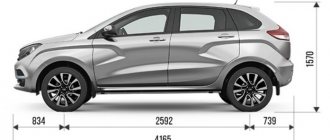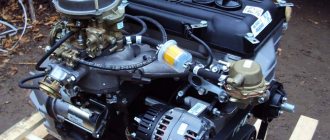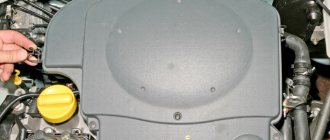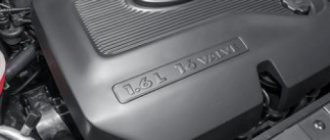Let's compare technical characteristics
If we compare the technical characteristics of these two engines, then in terms of choice, the advantage will be on the side of the 1.8 liter engine (model 21179): 122 horsepower versus 106 for the 1.6 liter (model 21129), acceleration to 100 km/h in 12.1 s (for the “rival” "for 12.8), the maximum speed that a car can develop is 188 km/h for a 1.8-liter engine, 178 for a 1.6-liter engine. Thus, if you are more interested in quality characteristics, then you should definitely pay attention to the first option engine. However, on the other hand, it turned out to be less practical in terms of savings.
Comparative characteristics table
The differences are: the volume of all combustion chambers in 21129 is 178 cc smaller and amounts to 1596 cc, therefore the 1.8-liter engine, in addition to more horsepower, also has a higher torque - 170 Nm versus 146 Nm.
The dynamic properties also differ: the highest speed of a car with a 1.8 engine. liter is 180 km/h, acceleration time to 100 km/h is 11.5 seconds. The 1.6 engine is inferior to the more massive version both in highest speed by 8 km/h and in acceleration from 0 km/h to 100 by 1.4 s.
KEY-DOP
It consumes fuel in the smallest quantity 21129 - in the city 9.7 liters per 100 km, in the suburbs 6 liters, on mixed roads - 7.5 liters.
21179 has a higher consumption in the city by 1 liter than the 1st option, in the suburbs on a mixed road - by 0.4 liters. It takes a lot of fuel per 100 km.
What kind of oil is recommended for Lada Vesta?
Regarding savings, the manufacturer recommends filling in SAE 5W30 or SAE 5W40 oil of domestic brands:
The plant calls foreign manufacturers an alternative oil for Vesta with the characteristic 5w30:
- Mobil (5w40 is also allowed, and for new cars 0w40);
- Motul Specific DEXO s2;
- Shell HELIX HX8.
It is precisely with its lower power and volume that the 1.6-liter engine turned out to be a more economical option, because its fuel consumption is slightly lower than that of its opponent: 9.3 liters - in the city; 5.5 – on the highway; 6.9 – in mixed mode (versus 10.2/6.5/7.5 for the 1.8-liter, respectively).
Now let’s move on from dry and boring numbers to a more lively “interior”. As for the drive, there are as many as three options: the larger engine has a timing belt from the German company INA (and as you know, there is no doubt about the quality of German products), the standard 1.6-liter power unit has a regular timing belt, but There is also a similar engine from the Nissan concern H4M (with a power of 110 hp, many sources indicate 114 hp, but this is incorrect), on which a chain is already installed.
In the latter case, we can talk about the “golden mean” between quality and efficiency. Although, in the case of the practicality of the drive, the Nissan engine “jumped ahead” of both of its brothers - here you can save on consumables (the chain is, however, more expensive, but it lasts much longer, there is no possibility of bending the valves).
Car with internal combustion engine “21129”, test drive on video
Good characteristics, so far I have noted 2 disadvantages for myself: oil consumption of 250 ml per thousand km and recommendations not to fill with 92-grade gasoline (after all, it is more profitable financially, and not all gas stations can find 95-grade in our city).
Vesta 92 is allowed. On the 127 engine the 95th
Well it turns out if 250 ml. for a thousand, then at 12 thousand I have about 1 liter of oil left? Is the oil dipstick lying?
This plant has secured itself. In order to refuse the warranty if something happens. In general, almost 3 liters from replacement to replacement, that’s crazy.
I have 6 pots (3.3 liters), 250 thousand miles, 18 years old car. Oil consumption is about 500 ml per 15 thousand km. From replacement to replacement, there is still some stock left. A 250 ml. per thousand, this is not a minus, this is firewood!
VAZ pleases with his Vesta in everything and even in the choice of engine for the new Vesta! The engine is, of course, powerful and has a lot of power, but if you want to drive fast and so that the car doesn’t suffocate, then you need to pay money for gasoline and oil! Although this engine is more economical than in foreign cars...
))))) more economical. FUNNY, my 1.7 with 130 horses eats about 8 or even less 95 liters in the city, on the highway within 100 km/h it eats 4.5-5.5 liters…. and a maximum of a liter of oil per 10,000, so the mileage on the engine is already more than 260t.km. …..
“Although this engine is more economical than on foreign cars...”
Is it really “powerful”? Is it really “more economical”? I have a 3.3 liter engine, the weight of the car is 1905/2460 kg - it eats 8 liters on the highway. So this engine has been produced since 1991! And there will be fewer valves... And a V-shaped engine... And the car is 18 years old... Do you want a comparison closer to Vesta? I once had a 1.6-liter Opel Cadet (sedan, 1987) - the consumption was 5.6 liters on the highway, although I didn’t drive quietly then.
The characteristics are quite good - I have become closer to my classmates in terms of performance. Although from a tax point of view the previous engine option was preferable.
There's something wrong with the oil. After 8000 km, oil consumption should be
2 liters I drove 8000 km without adding oil. Maybe a mistake, but in fact 250 ml per 10 thousand km?
Thank you for your comment, we will check with the AvtoVAZ representative and we will definitely answer you!
Is the vestemotor really disposable?
Of course it's a mistake! (or the machinations of vasophobes). The first car I had was a Moskvich AZLK 2140; its operating manual indicated oil consumption of 80 g/1000 km, and when this figure increased to 200 g/1000 km, the engine was considered worn out and required major repairs. How can oil consumption be so high on a new modern car? I have only driven 2000 km on my Vesta so far, I constantly monitor the oil, and the level has not dropped either.
Perspective
It should be noted that the power unit from the Nissan concern is superior to our domestic engines both in many quality and technical characteristics and in terms of efficiency (more reliable, more durable and uses less oil). Surely, not everyone needs exactly record numbers from a car and its engine - most car owners are looking for the most advantageous combination of reliability, practicality and efficiency, and therefore in this case it is worth paying attention to the Lada Vesta with a Nissan engine.
But there is one thing, the installation of the imported H4M engine has been postponed indefinitely, apparently due to the rise in price of the model and, as a consequence, the recoupment of such an upgrade is not profitable.
There is good news, on October 20, 2022, information was received that AvtoVAZ is testing another engine on the Lada Vesta, this is a 1.4-liter gasoline turbo engine from Renault and 150 hp, we’ll find out how this will end a little later.
But in order not to further mislead the public, it is necessary to mention in a few words the combination of these engines with various types of transmissions. So, the 1.8-liter engine is installed on all three types of gearboxes used in Vesta: robotic, mechanical and automatic. A conventional domestic 1.6-liter power unit is combined with a robot and mechanics. The Nissan engine is also installed on all three types of gearboxes. As most car owners understand, a car cannot develop its full engine potential with a robotic gearbox. But the choice of gearbox remains beyond the scope of this article; among the engines, it is worth noting the 1.6-liter Nissan concern due to its higher reliability and efficiency.
While the long-awaited LADA Vesta SW Cross station wagon was wandering around the representatives of our editorial staff, a certain number of impressions had accumulated that Drom.ru would like to share with you. Most of them are positive: we like the bright design, roomy interior, well-designed trunk, decent handling and high-energy suspension. But there are also negative aspects. The main complaints are about the 1.8 engine that did not live up to expectations, the extravagant “robot”, the not very high-quality interior and minor “jambs” in operation. Yes, in general we liked the Vesta Cross, but its shortcomings forced some to lean towards the proven “Koreans”, and others to opt for a used car altogether.
Grigory Aleshker - editor of crossover and SUV tests
Age - 47 years Driving experience - 29 years Drives a Renault 4F4
You should have seen how Grisha is getting ready to film the next off-road test: shovels, cables, hi-jacks, several pairs of boots, buckets, water bottles... You won’t be lost with him!
Lada Vesta SW Cross is the best creation of our automobile industry, which went into series. Delight at first sight! You look and think - well, the domestic automobile industry has risen from its knees, now it will run forward by leaps and bounds, go beyond the border - to conquer “capital countries” like the long-legged Russian beauties, which long ago became, together with the Kalashnikov assault rifle, vodka and black caviar, the calling card of the Soviet Union . Ugh, Russia, of course, is again “carrying me away” to “free times”!
Maybe this is because behind the bright façade of a modern raised all-terrain station wagon, problems with product quality that are so familiar to everyone born in the USSR are still hidden? Why do rough power window buttons scratch your fingers? Why on earth does the new 1.8-liter engine require adding oil between scheduled changes? Why the hell is the AMT “robot”, “sabotaging” every gear shift, constantly setting me up for an accident? What pests of the national economy came up with the menu for the media system? And this cheerful orange interior trim... Make a fool pray to God - he will even hurt his forehead, they crammed “oranges” everywhere, as a result, the “tidy” is almost unreadable, the eyes are dazzled by numerous inserts - “excesses in places” are obvious.
And yet, compared to our brothers in the Renault-Nissan alliance - the “Russified French” - our Vesta SW Cross is more comfortable: its steering wheel is adjustable for reach, and the driver’s seat has a normal backrest profile. The luggage space is downright Scandinavian neatness instead of French sloppiness: all these organizers, curtain shelves... On a broken grader, the heart again skips a beat with delight. Not a single passenger competitor can hit bumps like this, and most crossovers, except for the Duster and the Subaru crossover line, are not designed for such feats.
Vesta SW Cross is an ideal vehicle for the “village”, but the prices are by no means “rural”: from 770,900 rubles for the “base” to 866,900 rubles with a “robot” and a 1.8-liter engine in the top configuration - two-year-old all-wheel drive A 2.0-liter Duster with an excellent 6-speed manual transmission can be found for the same money.
Alexander Tychinin - test editor of Droma
Age - 28 years Driving experience - 10 years Drives a Chevrolet Cruze and BMW 325Ci (E46)
Sasha doesn’t do tests for Drom.ru very often, but you like them all. He can easily explain how a limited slip differential, torque converter or stability control system works, tell you what oversteer and understeer are, and then rush at a brisk pace along any race track.
What appeals to me most about the Vesta SW Cross is that it has a chance to increase the popularity of the station wagon in the eyes of Russians. Because it is no longer possible to look at this dull stream of sedans and crossovers. Choose station wagons: they are not only practical, but also beautiful! In addition, I am very glad that our people will finally be able to switch from “sevens”, “nines”, “tens” and “tags” to cars with a normal level of safety, equipment and convenience. But if you ask me personally, I will answer: “Thanks, no need.”
I will not buy Vesta SW Cross. Not because it has flaws in the interior, but the 1.8 engine drives as if our planet is running out of gasoline. Not because the suspension rattles, but every Vesta that comes off the assembly line rides “specially” because of the floating quality of the components. And not even because it still doesn’t have a normal two-pedal version, and VAZ’s “robot” will bore even the most law-abiding retired car enthusiast. Likewise, I will not take any of the competitors. Yes, Vesta is cheaper. But a price tag of 750–800 thousand, even for a well-equipped and very versatile car, is still a lot. And it doesn’t matter at all whether it’s Vesta, Fiesta, Solaris, Rio, Polo, Rapid or something similar.
Solaris, Rio, Polo, Rapid or Vesta - the cars seem to be quite good, even quite good. But for me this whole class smacks of some kind of hopelessness.
I don’t know how to choose “used” cars, but I still vote for “used”. Fortunately, I have many friends who periodically suggest good options. Two of my cars were purchased this way. And if I needed a car right now, I would wait until the last minute for the next option, I would get by on public transport, but I would not go to the dealer and would not make a down payment for the Lada and its companions, hung with extras.
Irina Zverkova – editor of Drom.ru
Age - 41 years Driving experience - 19 years Drives a Land Rover Defender 110
Irina is a true specialist in the social sphere, insurance and litigation matters. But he also has an excellent understanding of cars, and often helps us in tests.
Delight. Complete delight. The main thing is, of course, the appearance: a very beautiful car! None of my friends believed that this was an AvtoVAZ product. The motor is quite enough for me for everyday life. Inside there are pretty decent materials, complex architecture, excellent visibility and space. The multimedia system - with navigation and clear control logic - easily interfaces with smartphones and shows an adequate picture from the rear view camera. There is enough space in the back for three adult men - tested. Three large bags, bags from the supermarket, a heater and a few more purchases from a hardware store - for repairs at the dacha - easily fit into the trunk. The ideal Russian car?
Not without reservations. I couldn’t find the optimal driving position: I don’t fit the user’s percentile—I’m too small. The screen is not very sensitive and does not respond very quickly to touches, and the performance of the entire system is not up to par. But the most “stupid” thing, of course, is the “robot.” You need to get used to it, especially in city mode with frequent switching. It behaves no less strangely on slopes, allowing the car to roll back. On conditional off-road conditions, the Cross easily overcame a frozen dirt road with a small rut from the Defender, took the ascent to the roadway, and even allowed it to turn around and drive into virgin soil. What else do you expect from a front-wheel drive station wagon?
But one of the most significant caveats is the price. For a generation that remembers the cost of VAZ products 10 years ago, a million rubles is an infinite amount. On the other hand, appearance, comfort and spaciousness of the interior, decent technical characteristics - you have to pay for all this.
Alexey Stepanov - build editor, columnist
Age - 43 years Driving experience - 22 years Drives a Skoda Roomster Scout 1.2 TSI
Formally, Alexey is our “build” and observer. But he still has a whole bunch of responsibilities: buying and repairing dromomobiles, participating in tests and business trips.
Of all the members of the editorial board, it was I who was waiting for the release of the universal Vesta, not only out of professional curiosity. I couldn’t wait: six months ago I exchanged the rather rare Roomster compact van, which had served me faithfully for more than seven years, for an even more interesting and rare Roomster Scout. Maybe for the better? On the other hand, it’s a pity: Vesta SW was the most realistic option to purchase not only one that meets basic life requirements, but also literally a new car. A beautiful, practical, quite comfortable, decently driven, not afraid of our roads and - most importantly - economical to operate station wagon would be just right for me. But…
One of my past acquaintances once explained why he exchanged a new and progressive, but inexpensive and generally poorly developed phone in terms of software for another one - no better in terms of characteristics, but more expensive and of better quality. “Not happy...” Here is Vesta: it seems to have everything - the equipment (some options were not recently available on cars two or three classes higher), the design, and a well-thought-out luggage compartment... Many of the initial shortcomings have been corrected. But I feel uncomfortable in her flat chair. Correct driving habits are spoiled by unclear feedback on the steering wheel. Blocks of buttons and keys vary in pressing force and working strokes - as if they were hastily assembled from different machines. And, of course, unfinished software: engine twitches when driving under tension, “glitches” of the built-in navigator, the climate control and automatic windshield wiper are still not working properly (at the same time, the automatic headlights work just exemplary). And if we add to this the shortcomings of the 1.8-liter engine and the “robot” of our station wagon...
If Vesta SW had appeared, as promised, a year earlier, and I had bought it, then I think I would hardly regret it. Just like now, I don’t regret it when I get to drive an editorial car. But in comparison with Scout, it’s not happy... (((
Andrey Bak - photographer
Age — 37 years Driving experience — 19 years Drives a VAZ-2105 Drift “Zhigulyator”
Who would need our articles without Andrey’s juicy and clear photographs? For many years now, the “pictures” for the Moscow edition of Drom.ru have been his responsibility. Well, he knows so much about cars that you never even dreamed of!
As a car photographer, it is important to me that the car is easy and pleasant to photograph. The most photogenic are expensive and sports cars. You can hardly find such “cuties” in the budget segment. But I spent my two or three days test driving the Cross with great interest, and there was a whole bunch of nice “cards” left on my phone and on the camera: this usually doesn’t happen with other Russian cars. Photographing Vesta Cross is a pleasure. Bright and rich color, pleasant shapes, attention from others - everything was “deliverable” during the shooting. Outwardly, Vesta was definitely a success! And there are almost no questions about the interior, the engine, and the handling: very worthy for AvtoVAZ.
People even began to forget about competitors in the form of Solaris, which until recently were the ultimate dream in their class. Such AvtoVAZ products no longer have to be fiercely defended and explained why they cost as much as a foreign car.
The main “but” in our modification is the robotic gearbox. When trying to actively drive, the “robot” stalls, and the driver is overcome with fear and doubt that with the next peck he may not get through. I couldn't relax with this gearbox. We'll have to wait a little longer until the "machine" becomes a reality.
Alexey Antropov - representative of Drom.ru in the Ural region
Age - 32 years Driving experience - 11 years Drives a Skoda Octavia A5 1.8 TSI and LADA Granta
Block man, rock man. Alexey seems to be able to live in dromomobiles for days. Few people have such experience of driving across our vast Motherland.
After the dull “blonde” sedan, the first and strongest impression is the color! Bright, rich, shimmers in different shades depending on the lighting. What a photo-maniac's dream! But in the cabin, such a color scheme is no longer so much pleasing as it is distracting, and the vigorous lighting - after the pale and green ones in the Vesta-dromosedans - is completely annoying with a riot of colors. It would be better to make the cup holders deeper. And in general, in comparison with the “blonde”, no revolution happened in two years. Still the same... uh, pencil, but from a slightly different angle. But in a “damaged” sedan, the noise is worse, and the suspension rattles more. But the workplace is calmer, and the engine, despite its smaller volume and power, is more responsive and playful.
But the main advantage of Vesta Cross is a station wagon body and a trunk that can be loaded under the roof. But do not forget that you will have to go “deep” for the “spare spare”: you will need to pull out all the luggage, collect all the shelves and organizers, put it all on the dirt road and then get the wheel. Well, then in reverse order, several times, taking into account the stop for tire fitting. Here you have to choose: either load less or take out more.
But the most obvious “evil” is the “robot”, which begins to infuriate you at the very first traffic light. Having gotten used to it, the brain makes allowance for the imperfection of the design used and forces its right foot to play along with the machine in order to somehow smooth out the “special effects”.
Anton Serkov – project manager “Proven Cars”
Age - 28 years Driving experience - 10 years Drives a Toyota Corolla 1.3
Anton helps Drom.ru visitors choose a car with the help of the “Proven Cars” project, which he runs. In addition, a good half of the 100,000 mileage of our Captur is his merit.
With the release of Vesta, AvtoVAZ managed to attract the attention of those who had not even thought about buying a Lada before. Two years later, with the debut of the station wagon, we managed to repeat this. But you can’t fool me, an experienced “pelvic operator”, I can easily identify all the “native” Togliatti features: the howling of the box cannot be hidden behind good sound insulation, pressing the buttons is traditionally followed by the clicking of the switches, and the hastily assembled trapezoid of windshield wipers “pleases” them with the wrong position. Well, hello, Lada!
They say they did a lot of work on the car. It seems to be so: Vesta SW Cross looks like an adult, the suspension is energy-intensive and quiet, and the ergonomics are now an honest C - for VAZ this is a compliment. The car with all its appearance wants to show that the times of garage tinkering are gone, and now there is no need to “carry a sled” - you can just ride for your own pleasure. But, firstly, with a “robot” and a completely damped accelerator, there can be no talk of pleasure, and, secondly, the “party” is now simply moving from the garage to the dealer, who must eliminate the shortcomings you have identified.
However, if you are lucky with a specific example that will not act up (the chance is like winning at a casino), then the car is well worth your attention. Junior trim levels are already equipped with everything necessary, but there is also the opportunity for everyone to overpay for unnecessary “whistles”. At the same time, you feel like an agent of the manufacturer, participating in the endless improvement of the model. Therefore, I personally prefer the Rapid to the Russian station wagon, which, for the difference in price, provides the main thing - the feeling of a car.
Sergey Gusarov - news editor
Age - 30 years Driving experience - 11 years Drives a BMW 325iX (E30)
Our Sergey is always up to date with all the news and significant events in the global auto industry. He is a real automotive encyclopedia!
From the outside, the car is inviting. I want to photograph her from different angles. You can even boast about it to friends who don’t closely follow events in the automotive world, but always have a couple of hackneyed jokes about AvtoVAZ on hand. “Well, look, it turned out to be a normal domestic car,” I want to tell them. And Vesta Cross passengers may well like it. The cabin is spacious and quiet, and the suspension provides an acceptable level of comfort. The interior elements could be nicer to the touch, but this is a budget car.
The engine and gearbox, however, are disappointing compared to industry standards. All the days I got acquainted with the editorial Vesta Cross, I tried to catch with my vestibular apparatus the range in which the motor “travels,” but I was unable to do this. A lot has already been said about “robot” (and not very good). There is a suspicion that choosing a traditional “automatic” would deprive Vesta of a competitive price advantage, and would also force the public to look more closely at other shortcomings that can now be forgiven.
The willingness of Russian buyers to turn a blind eye to the shortcomings of domestic technology, which has been developing over the years, and the monopoly position of a small, but beautiful and quite affordable “all-terrain” station wagon, will most likely make the Vesta Cross a very popular car in the Russian Federation. And, in my opinion, it’s still deserved.
Dmitry Krotov — editor-in-chief of Droma
Age - 39 years Driving experience - 20 years Drives an Alfa Romeo GTV 3.0
Dmitry tries to unite the efforts of all Drom.ru authors, to be demanding of them, but at the same time delicate, to create conditions so that you can read more interesting materials.
Just when my time came to take a ride on the obvious “star” of our automobile industry - Vesta SW Cross, I was “lucky” to find myself behind the wheel of a VAZ-2112. Yes, yes, the same “twelve” that until recently were a dime a dozen on the roads. And I’ll tell you what, dear readers: in this comparison, Vesta is simply an ultra-modern and awesome car in all respects. In this contrast, you immediately understand why a Russian car suddenly came close in price to a million rubles.
Design? Yes, this is the most beautiful car from Russia in the last half century! Salon? There is plenty of space, and the organization of luggage space is absolutely top notch. The Cross drives no worse than the Korean “state employees”, and even if it’s on a dirt road and potholes, it’s not possible to catch up at all. But, unfortunately, not everything is so smooth. The number one disappointment is, of course, the “robot”. Given the largely peripheral distribution of the West, I simply encourage everyone to opt for the “handle” if you do not want to nod your heads at every switch. The second obvious disadvantage is that the long-awaited 1.8 engine does not live up to expectations: neither in terms of traction, nor in fuel consumption, nor in smooth operation. Buy 1.6 - you won’t feel the difference of 16 forces. The third problem is the “cheap” interior compared to the same “Koreans”. Well, the fourth nuance is a carriage and a small cart of small “spliffs”. However, many will object that Vesta Cross is cheaper than the bestsellers in the budget segment.
Your truth. As well as the choice is yours: should you prefer a better packaged and very spacious domestically produced station wagon to the problem-free Solaris, Rio, Polo (underline as appropriate) in poorer versions? If you still decide, then take version 1.6 on the “mechanics”. You'll also save a lot of money.
Have a question about Vesta Cross? Ask Drom and we will find the answer!
Engine Specifications 21179
We invite you to take a closer look at this engine. Below we describe all the main parameters that the 1.8 engine on the Lada Vesta Cross has.
- index - 21179;
- working volume - 1.8 l;
- engine power - 122 hp, which is achieved at 6050 rpm;
- torque - 170 Nm, at 3750 rpm;
- environmental class - Euro5;
- fuel type - AI92 or AI95;
- average fuel consumption per 100 km;
- Manual Transmission;
- urban cycle - 10.7 l;
- suburban - 6.4 l;
- mixed cycle - 7.9 l;
- automatic transmission;
- urban cycle - 10.1 l;
- suburban - 6.3 l;
- mixed cycle - 7.7l.
The maximum engine life, according to the passport data, is about 200 thousand kilometers.
TRANSMISSIONS
In this regard, AvtoVAZ also offers a wide choice. The main gearbox will be a 5-speed manual, which is also installed on other VAZ models. In 2012, it was modified, some components were replaced, Japanese and German parts were supplied, the volume of oil poured was reduced, and other work was carried out. As a result, the gearbox is quieter, shifts have become more convenient, and vibrations have decreased.
Technical characteristics of Lada Vesta gearboxes.
The Lada Vesta will not receive a classic automatic transmission, which has upset many visitors to dealer showrooms. Its place was taken by a “robot” of the AMT type, due to its low cost of production, created on the basis of a manual gearbox bearing the index 2180. Despite the rougher work (small jerks and jolts when switching), the use of components from the world companies ZF and VALEO, coupled with less appetite and no need to warm up, the robot has a real chance of becoming a worthy alternative to an automatic transmission.
Weight of Lada Vesta engines and gearboxes.
In addition, the Lada Vesta will also receive a CVT, which will be transferred to the domestic sedan from the Japanese model Nissan Tiida. However, there is no more complete information on it yet.
Nominal filling volumes of Lada Vesta (in liters).
Engine disadvantages
The engine entered mass production and installation with the launch of the new Lada Vesta. Enough time has passed since then, during which car owners and experts have identified a number of the most common breakdowns. These include:
- beating of hydraulic compensators. This problem is not new for AvtoVAZ. Quite often, 16-valve engines produced by a domestic manufacturer suffer from this “sore”. It appears as a result of the use of unsuitable oil or insufficient volume of oil directly in the engine.
- increased oil consumption. Another problem that migrated to VAZ engines, migrated to the new engine with index 21179. As a rule, it can be solved only after replacing the connecting rod and piston group. It’s good if the car is still under warranty and the dealer will perform the procedure for free. If the warranty period has expired, the financial burden of replacement falls on the owner.
As for the rest of the engine’s operation, the overwhelming majority of owners have no complaints about it. The engine has proven itself on the positive side. Timely and correct maintenance is enough and you will not recognize problems with the engine for 150-200 thousand kilometers.
By the way, if you are afraid to take a Vesta Cross with an automatic transmission, then your fears are completely unfounded. As practice shows, the service life of such a box is quite comparable to the mechanical version.
What features does the VAZ-21129 engine have?
This engine can be equipped in a Lada Vesta car with either a manual or automatic transmission. The ancestor of this unit was the well-known VAZ-21127 engine, which is considered obsolete and does not meet the requirements of environmental standards according to the Euro-5 system.
The updated unit has modern options and progressive design features, which allows it to be compared with engines of foreign-made competitors. Among these features, experts include:
- reduced compression ratio, allowing the use of fuel with a lower octane number;
- modified exhaust system;
- structurally redesigned intake system;
- updated ECU firmware.
The appearance of the engine has also become more modern. The perimeter of the unit is “overgrown” with all sorts of sensors of the electronic control system.
Note that this version of the engine is most common in the “Comfort” configuration. The designers also took care of creating a sports variation of the car, where they placed a forced engine capable of developing 150 hp. With. The unit considered here served as the basis for such a “fiery heart”. What engines are installed in all versions of the model?
The engineers were able to achieve the indicated results by applying the following design solutions:
- Reduced losses due to friction in the cylinders. Here the idea of reducing the thickness of both compression and oil scraper rings was implemented.
- Improvements to the exhaust system, where a structurally new resonator is used.
- Use of lightweight pistons made of a special aluminum alloy.
On a note! It has been proven by experience that the natural oil consumption in a VAZ-21129 engine is 3 ml per 1 liter of gasoline consumed. This means that approximately 25% of 1 liter of oil present in the engine will be wasted over a mileage of 1 thousand km. This is a good result, because in comparison with domestic engines, the power units of some foreign cars consume much more lubricant over the same distance.
Now let's look at the main characteristics and features of the VAZ-21129 power plant:
- power, as already noted, 106 hp. With.;
- the torque is 148 Nm;
- It is possible to boost the unit to 150 hp. With.;
- you should start changing the oil every 15 thousand km;
- uninterrupted operation of the engine at any speed is partly achieved thanks to the use of a special damper system inside the intake manifold;
- the working pressure value in the chambers (compression) is 12.5 atm;
- predicted resource – 200 thousand km.
Which motor oil to choose?
In order not to make a mistake when choosing engine oil for Vesta SW Cross, as is the case with other cars, you need to clearly understand the conditions under which the car will operate. First of all, you need to choose the appropriate viscosity of the engine oil. The operating instructions say that the following types of oils are suitable for this engine:
And this is where the nuances mentioned above begin. So, for example, if the car is operated in colder regions, it is better to give preference to liquid oils: 5W-30 or 5W-40. And if the engine is new and has low mileage, it is allowed to use oil with 0W-40 ratings.
If you live in a warm region or use your car exclusively in the spring and summer, you can safely fill in 10W-40 and 15W-40 oils.
Next, you need to select the optimal quality class. Again, according to the operating instructions, it is recommended to use oils of at least SM class according to API or GF-4 according to ILSAC.
State of the valves when the timing belt breaks
Like any modern engine, the Lada Vesta SV Cross engine with a displacement of 1.8 and index 21179 is susceptible to this defect. Indeed, when the timing belt breaks, the valves in the engine become deformed. This happens mainly due to the fact that manufacturers strive to achieve greater power with the same engine size. To make this possible, it is necessary to lighten the connecting rod and piston group while simultaneously increasing the compression ratio.
With this approach, it becomes impossible to groove the pistons in order to exclude the possibility of them “meeting” the valves in the event of a direct belt break. Regardless of the nature of the breakdown, this means a broken timing belt, jamming of the pump and tension roller, you will be faced with a major overhaul.
Engine assembly materials 1.8 Lada Vesta SV Cross
Let's continue our analysis of the engine. Next, we suggest you take a more in-depth look at the parts from which this motor is assembled. Parts List:
- The timing belts used in these engines are manufactured by Continental. The declared belt resource is 180 thousand km. How truthful this can only be learned from the owners of Vesta Cross SV or from our own experience;
- Continental also supplies injectors. This model of nozzles has a longer life and increased performance;
- valves from Mahle;
- pump from GMB. Its resource corresponds to the timing belt and is the same 180 thousand km;
- an oil pump from GMB is also used;
- but the installed camshafts were manufactured by Toyota Tsusho. They compare favorably with the old ones in weight;
- INA phase adjustment mechanism.
Distinctive features of the engine
Many car enthusiasts rightly note the external similarity of the 21179 engine with early examples of 16-valve VAZ engines and, in particular, with the 1.6 engine. However, it was possible to achieve a larger engine volume compared to 1.6 not by increasing the diameter of the cylinders, but by increasing the piston stroke in the previous cylinder. To realize the idea, it was necessary to remake the connecting rod and piston group and install a new crankshaft.
It is worth noting that the new engine uses variable valve timing, which was not present on any previously released version.
The oil and cooling passages have also changed significantly.
New injectors with increased performance, mentioned above, were needed due to an increase in engine displacement. In addition to them, it was necessary to install a new throttle valve and increase the volume of the oil pan to 4.4 liters. An increase in the volume of oil in the engine entailed the installation of a more efficient pump. The intake ports have also become larger.
It is worth mentioning a new method for reading mass fuel consumption. An absolute pressure sensor and an air temperature sensor are now responsible for this.
Why was the 27th engine replaced with the 29th?
The VAZ-21127 engine was good for everyone, except for one thing - it complied with Euro-4 standards. For Vesta sedans produced since November 2015, this option would not be suitable. It was necessary to solve a difficult problem: to improve the environmental class without increasing the volume and without losing power. And as a result, a new family of 16-valve engines appeared in the VAZ arsenal. We are talking about motors 21129 - they really meet the latest environmental standards.
The first Vesta engine, produced by VAZ
To move to the Euro-5 standard, engine 21127 had to be modified:
- The resonant intake system, as well as the exhaust system, have been completely redesigned;
- The ECU controller (ECM) has received new firmware - even the algorithm that regulates the volume of the resonant chambers has been changed;
- Engines 21127 and 21129 have slightly different compression ratios - 11.0 versus 10.45;
- The engine suspension was also improved: it became possible to mount it on a subframe.
Speed characteristics of Lada Vesta Cross engines of 1.8 and 1.6 liters.
Engine performance readings clearly demonstrate the final performance. We note the high-quality settings of the manufacturer. The maximum torque of 170 Nm can be achieved at 4000 rpm. At the same time, at 5500 rpm, the engine produces its maximum 122 hp. With.
Video about maintenance and repair of the Lada Vesta Cross engine:
When choosing a car, you need to decide not only on the brand, color, appearance, but also the technical parameters of the car. Whether or not to operate a more powerful engine is preferable, only the driver can decide, because everyone has their own preferences. If the choice falls on the Russian Lada Vesta Cross, you will need to choose between 1.6 liter or 1.8 liter engines.
Comparison of prices and options
Prices for Lada Vesta Cross with 1.6 and 1.8 engines differ insignificantly - 770 thousand and 795 thousand Russian rubles in the “Lux” configuration. Unfortunately, the 21129 engine is available exclusively in this version; if you are interested in richer modifications, you will have to fork out for the 21179 engine.
The equipment for these two cars is absolutely the same. As for safety, there are front and side airbags, child seat mounts, ABS, BAS, EBD, ESC, HAS, crankcase protection, alarm, headlights, door locks. The doors lock automatically and have an anti-theft device.
The interior includes sockets at the front and rear, a case for glasses, an on-board computer, lighting, and a sun visor. The seat upholstery can be chosen in orange or grey. The rear seat reclines.
For driving comfort, the seat belt and steering column, as well as the driver's seat, are adjustable. The interior has an air filter, climate control, and the seats can be heated. Vesta also provides for weather and parking sensors. An audio system is provided.
The exterior includes exterior mirrors, spare tire, R17 alloy wheels, cargo rails and fairings.
Advantages and disadvantages of the 1.6 engine
The 1.6 and 1.8 engines installed on the Lada Vesta SW Cross have their advantages and disadvantages. When choosing a car, you need to pay attention to the characteristics of its power unit, because the quality of the trip and possible financial costs for repairs will depend on its reliability.
Main advantages:
- Complies with European standards;
- Complies with environmental standards;
- The engine contains hydraulic compensators that smooth out the shock load;
- Time-tested design.
Flaws:
- Hydraulic compensators may knock for some time immediately after starting;
- Not the most economical;
- Over time, engine oil may develop.
Pros and cons of the 1.8 engine
This power unit cannot be safely recommended to anyone who has decided to buy a Lada Vesta Cross and has a few extra tens of thousands of rubles, since it is also not ideal, and has not only advantages, but also some significant disadvantages.
Main advantages:
- Power and torque are noticeably greater than those of a smaller engine;
- Smooth ride;
- Confidently pulls a loaded car.
Minuses:
- Uneconomical fuel consumption;
- The difference in acceleration with the 1.6 engine is insignificant;
- Less environmentally friendly;
- Repairs are more expensive;
- Noise during operation.
If you choose a Vesta SV Cross with a 1.6 or 1.8 engine, then first of all you need to test drive cars with both types of power units and understand for yourself whether it’s worth overpaying for additional horsepower or not.
DIMENSIONS OF LADA VESTA
It was not for nothing that Bo Inge Andersson said that in terms of size, the Lada Vesta will be one of the leaders in the class, which will largely ensure its popularity. That’s right, strictly speaking, the car is difficult to unambiguously classify as segment B, since it is at the junction of classes B and C. The length of the sedan is 4,440 mm, with a width of 1,764 mm and a height of 1,497 mm, and this is noticeably longer than the Hyundai Solaris (4,375 mm, 1,700 mm and 1,470 mm), which is one of the main competitors of the Russian car.
The wheelbase of the Lada Vesta is 2,570 mm, and the track of the front and rear wheels is slightly different - 1,495 mm and 1,502 mm, respectively. The ground clearance of the new product is traditionally higher than that of foreign cars and is equal to 171 mm under the crankcase of the power unit, provided it is fully loaded, and also 144 mm, subject to change under the engine mudguard. This, together with a front overhang of 860 mm and a rear overhang of 915 mm, as well as approach and departure angles of 16.6° and 14.2°, provides the ability to confidently drive on country roads, which is important for residents of small towns.
The luggage compartment of 480 liters of usable volume is also one of the most spacious in the class, and the payload of 487 kg allows you to take a lot of luggage “on board”. Vesta's curb and gross weights are 1,178 kg and 1,653 kg, respectively. But the distribution of curb and total weight along the axles is different. In the first case it is 60/40, and in the second – 52/48. Regarding towing a trailer, the permissible weight for a device equipped with brake mechanisms is 900 kg, and for one without brakes - only 450 kg.











